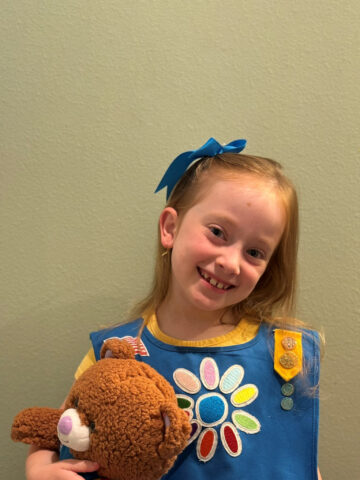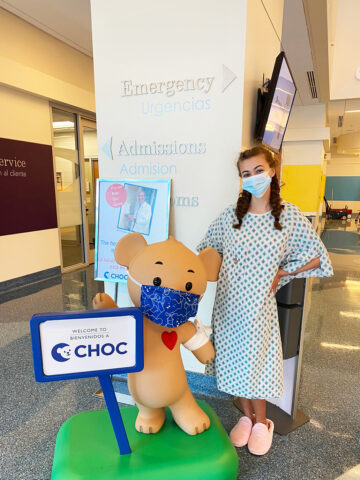By Dr. Eric Ontiveros, chair of pediatric anesthesiology at CHOC
You want to know your child who needs surgery is in the best hands. Kids’ bodies are completely different inside, and pediatric specialists know the difference. Pediatric anesthesiologists at CHOC, who lead your child’s surgery team, have compiled a list of questions commonly asked before surgery. Any question about your child is a good question. If there is ever anything you do not understand, ask your child’s surgery team. They are there to help.
Before surgery, you and your child will be taken to the pre-operative unit, or “pre-op.” A nurse will review the information needed to safely perform the child’s procedure. The surgeon and the anesthesiologist will evaluate your child and answer any questions you have. You will be asked to sign any necessary paperwork and then accompany the child to the operating room doors. After another hug and kiss, the team will assume care of your child.
You child’s safety is our biggest priority. Having a parent in the operating room can distract the team’s focus away from your child. To ensure the safest environment possible for your child, you will be taken to the waiting room.
Depending on the child’s age and planned procedure, we may start an IV in the pre-op unit. An IV is a small plastic tube inserted into the vein and used to deliver medication. Depending on the age of your child, a small amount of anti-anxiety medicine may be given orally before placement of the IV. The staff will also use special numbing medicine to reduce the discomfort of IV insertion. A child life specialist will provide age-appropriate distractions such as books, games, or bubbles to aid in the process.
Anesthesia is broken down into three main categories: General, Regional, and Local.
General anesthesia makes and keeps a person completely unconscious (or “asleep”) during the operation. It can be administered through an IV, or by inhaling an anesthesia gas delivered by mask.
Regional anesthesia is when a drug is injected near the spinal cord, numbing a large area of the body. An example is an epidural. It is often combined with general anesthesia in kids and used for pain control after the surgery.
Local anesthesia numbs a small, specific area of the body- for example, a foot, hand or patch of skin. It can be given as a shot, spray or ointment. Local anesthesia is often used to reduce the pain after surgery.
The anesthesia your child receives is tailored to their needs and depends on factors including:
~ The type of surgery
~ The location of the surgery (hospital, outpatient surgery center or doctor’s office)
~ How long the surgery will take
~ Current and previous medical condition
~ Previous reactions to anesthesia (in your child or family members)
~ Medications your child is currently taking
~ Age, height and weight
No matter which type of anesthesia your child receives, your anesthesiologist will be available before, during and after the operation to monitor the medications your child receives and ensure they are receiving the right amounts.
Your child may receive medication to help them remain calm and feel sleepy before the procedure or surgery. This medication is usually given by mouth and before starting the IV. Many children are curious about the operating room and prefer to experience falling asleep in the OR, so they skip the sedative.
Your child will usually wake up with their IV in place. This is helpful as additional medications are sometimes needed to treat pain or nausea. Your child will also wake up with several monitors that help the anesthesiologists and nurses monitor your child’s recovery from anesthesia. These monitor blood pressure, heart rate and oxygen levels. As your child recovers from anesthesia, the IV and monitors will be removed.
The anesthesiologist will begin to “wake up” your child after the surgery is completed. This amount of time varies from child to child and is dependent on their medical history and type of surgery performed. This can take up to an hour, and most children wake up in the recovery room (also referred to as the post anesthesia care unit, or PACU) in a shorter amount of time. Full recovery can take up to several hours.
After the surgery is completed, the surgeon will speak with you in the Tidwell Procedure Center lobby. It may take an additional 20 to 30 minutes for the nursing staff and anesthesiologist to recover your child from anesthesia before having you enter the recovery room (PACU).
If your child is going home after surgery, the nurse will offer your child a snack and drink in the recovery room. No driving for teens the day of surgery. The surgeon will provide a school note if time off is required. If a hospital stay is required, and depending on the procedure, the surgeon will order the appropriate diet.
Children usually spend 30-90 minutes in the recovery room. Patients heading home will be provided a discharge plan. This plan may include instructions on how to take care of the operative site, what medications to take, what your child should eat that day, and what activities the child may participate in. It will also have instructions on what to look out for and when to call the doctor.
Download a copy of the discharge questions worksheet.
You will receive a phone call from a CHOC nurse within 72 hours of the patient’s discharge from the hospital. Our nurse will ask about how the child is feeling and will be able to answer any additional questions you may have.





